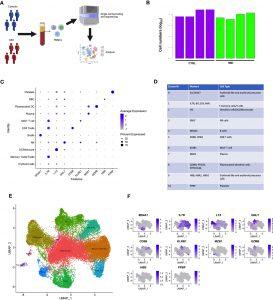In a recent study, researchers showed that altered B cell function in children with mitochondrial disorders, leads to a weaker and less diverse antibody response to viral infections (Figure 1). The study focused on analysing gene activity in immune cells of children with mitochondrial disorders, particularly B cells, which are responsible for producing antibodies to combat viral infections. The findings shed light on how B cells are impacted in mitochondrial disease by studying human patients, a novel approach in this research field.

Figure 1: Identification of scRNAseq cell clusters in children with MtD and controls. (A) Peripheral blood mono nuclear cells were collected from children with MtD (N = 4) and matched controls (N = 4). Single cells were sorted, followed by isolation of RNA and sequencing. (B) Log10 cell numbers for analyses from children with MtD and controls. (C) Differential gene expression analyses identified cell specific markers. A dot plot for cellular marks and their alignment with various cell populations was constructed. (D) Table of RNA markers of various immune cell subsets. (E) UMAP clustering of immune cell populations as identified using selected marker genes. (F) Feature plots showing the distribution of cellular markers for the identification of immune cell populations.
Through single-cell RNA sequencing, researchers examined immune cells found in the blood of these children. They observed that during stressful conditions, the cells produced a microRNA called mir4485. MicroRNAs are small RNA molecules that regulate gene expression, influencing when and where genes are activated or deactivated. In this case, mir4485 controlled cellular pathways to support cell survival.
To cope with infection caused stress, the B cells produced the microRNA to enhance survival. However, the B cells, already limited in energy due to mitochondrial dysfunction, proved too fragile to endure the stressful conditions. Consequently, their weaker antibody response hampers the immune system’s ability to recognize and neutralize invading viruses and clear infections.
This groundbreaking research offers valuable insights into the immune dysregulation in children with mitochondrial disorders. The findings pave the way for potential future treatments tailored to improve their immune responses. Translational studies will be critical in applying these discoveries to clinical practice and advancing therapeutic strategies for patients with mitochondrial disorders.
Journal article: Gordon-Lipkin, E.M., 2023. Primary oxidative phosphorylation defects lead to perturbations in the human B cell repertoire. Frontiers in Immunology.
Summary by Stefan Botha










